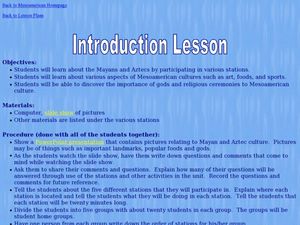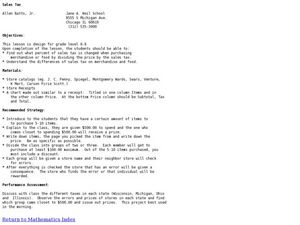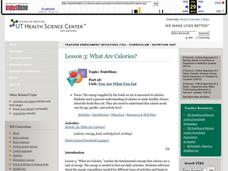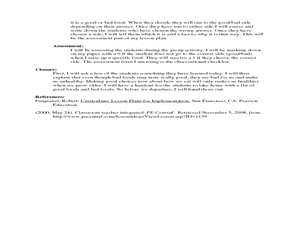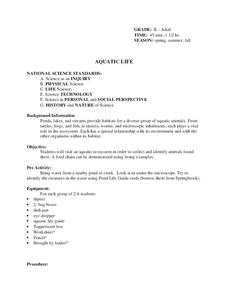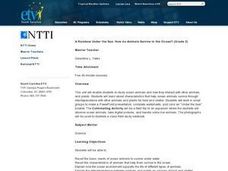Curated OER
Mesoamerican Cultures
Students compare and contrast the Mayan and Aztec cultures. In this Mesoamerican cultures lesson, students visit classroom stations that feature the landmarks, popular foods, and gods of the 2 cultures. Students discuss their favorite...
Curated OER
Investigation Xylem
Students investigate how water travels up the stem of vascular plants by using food coloring to stain the xylem of a number of different plants. They know the function of leaves, stems, and root at the end of the experiment.
Curated OER
How Much?
Fifth graders problem solve to determine if a fundraiser will be successful in the money raising activity. In this problem solving instructional activity, 5th graders read a book about fund raising and write down important vocabulary...
Curated OER
Caribbean Culture Day
Students are introduced to about Caribbean culture through the preparation and sampling of Caribbean food, as well as become familiar with Caribbean folk songs and poetry. They also experience blindness in order to form a deeper...
Curated OER
Health: Basic Minerals
Students examine minerals as food nutrients and discover their importance as food sources in the diet. Among the learning options are completing worksheets, creating recipes, making billboards, and actually preparing some recipes rich...
Curated OER
Sales Tax
Learners explore the concept of sales tax. In this sales tax activity, students work in groups to spend $500. Learners calculate the discount and sales tax on each item. Students buy between 5 to 10 items.
Curated OER
Defining Agriculture and Natural Resources
Students define agricultural using concept maps. In this agriculture activity, students use concept maps to determine the ideas that are related to agriculture such as farming, food, flowers, and forestry before defining the word...
Curated OER
Cave Art
Students explore cave art. In this Neolithic Age lesson, students get into groups and research a given topic. Students create a poster with information and visual aids. Students then look a pictures and watch a DVD about artifacts found...
Curated OER
What Are Calories?
Students examine calories for the human body. In this calorie instructional activity, students explore the energy expenditures needed for different types of activities and how many calories are needed to support daily functions.
Curated OER
Water, Water Everywhere
Students explain the important role of water in the body. For this adult health lesson, students examine foods with high water content. They share ways to get the recommended amount of water per day.
Curated OER
Owl Pellets
Students utilize owl pellets to explain part of the natural food chain, and the skeletal system. They construct a rodent skeleton from the skeletal parts foundin the pellet.
Curated OER
The Invasion of the Medfly
Students examine the invasion of the fruit fly in California. In groups, they observe and record the fruit fly's lifecycle and how they affect humans in society. They also discuss the history and geography of the fly and the different...
Curated OER
Goods and Services
Second graders demonstrate their understanding of goods and services through group presentation. In this simplified economics lesson plan, 2nd graders are divided into groups representing a particular market. They then create posters...
Curated OER
Edible Soil
Students model the soils layers using Oreo's. In this lesson students use their favorite food items to create a model of soil layers. A discovery lesson from a youth camp is adapted for classroom modeling and discussion of soil ecology....
Curated OER
Anyone for Sugar?
Pupils inquire about how much sugar they consume on a daily basis. In this healthy habits demonstration, students examine how much sugar is in a variety if foods by spooning out teaspoons and placing into a bowl. Pupils discuss...
Curated OER
Diet and Exercise Activity
Students explore their physical abilities by participating in team sports. In this physical education lesson, students collaborate in groups in one of several team sports before moving on to the next station. Students discuss healthy...
Curated OER
Make Waves
Sixth graders discover, through exploration, the basic characteristics of waves. After a lecture/demo, 6th graders work in groups and participate in a series of labs where they investigate waves. Each group presents its findings to the...
Curated OER
Starvation in the Ghettos
Students investigate how human beings survive under camp and ghetto life's extreme condition while understanding the USRDA requirements. They recognize the suffering and loss of life due to the lack of adequate nutrition.
Curated OER
Magnets, Electromagnets, and Motors
Learners investigate the concepts of magnetism and its properties. They construct a magnet and test foods for iron content. Then students define the use of a motor and make their own electric motor while working in small groups. Then...
Curated OER
Aquatic Life
Students explore aquatic life. In this science instructional activity, students visit an aquatic ecosystem and collect animals found there. Students create a food chain for the aquatic ecosystem.
Curated OER
Cultural Multimedia Projects
Fifth graders research a cultural element (art, music, literature, food, clothing, religion, etc) and work as a group to create a multimedia presentation. This lesson focuses on the process of creating a multimedia presentation.
Curated OER
A Rainbow Under the Sea: How do Animals Survive in the Ocean?
Second graders read books, watch videos, complete worksheets and participate in class discussions about ocean animals. They, in groups, design PowerPoint presentations on selected marine animals.
Curated OER
Go Native!
Students explore the five Native American regions. They compare and contrast the dwellings, clothing, and tools of the Native American groups. Students research one group of Native Americans. They build totem poles, pueblos, weave...
Curated OER
Cultural Characteristics
Students are introduced to the various types of cultures found in the world. Using the internet, they research a culture they are interested in and answer comprehension questions. In groups, they demonstrate in a PowerPoint presentation...


